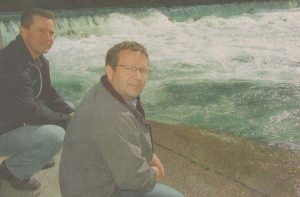 Philip Round, Comox Valley Echo
Philip Round, Comox Valley Echo
Published: Friday, May 11, 2012
Trials to see if controlling river flows could boost the summer Chinook salmon population in the Puntledge are about to start.
B.C. Hydro, which can influence flows by adjusting the amount of water released from Comox Dam, will be working with the Department of Fisheries and Oceans and Project Watershed volunteers on the program.
The focus of their attention is the fish diversion weir at the DFO’s Lower Puntledge River Hatchery, off Powerhouse Road in Courtenay.
When the fish return to the river to spawn between May and August, the weir prevents many of them going further upstream – but when the water is flowing deep and fast, more of them are able to leap over the barrier.
Being able to stop the fish at that point is what staff at the hatchery want, as they can then net and transfer them to tanks held at the ideal 15 degree temperature needed for summer Chinook to thrive until they are ready to spawn.
That allows the maximum number of eggs to be gathered so the hatchery can bring on a new generation to be released back in the river to start the life cycle over again.
Now a series of tests is to be undertaken to work out the impact of different river flows on the ability of returning salmon to leap over the weir.
As the summer Chinook start to return, different pulses of water will be sent from the dam on different days during May and June to see how the fish behave.

In summer, river flows are generally low enough to keep most fish downstream of the barrier, but in the early stages of the return they can be significantly higher.
B.C. Hydro has wider responsibilities to ensure water levels upstream at Comox Dam are controlled, and sometimes needs to release extra water through the sluices.
At other times, heavy rain or late snow melt, coupled with uncontrollable additional flows from the Browns River tributary, sends more water over the weir than DFO would like to see.
But those acts of nature could, to some extent, be mitigated by B.C. Hydro if it knew what the ‘tipping point’ at the weir for fish really was.
The power company might, for example, be able to hold back water at the dam for a while so as not to exacerbate short-term increased natural flows.
So the trial now about to start will see the river being made to run at 60, 70 and then 80 cubic metres a second as fish approach the weir, to see what the tipping point really is.
If, for instance, it were discovered that most fish can’t leap over the weir at 70 but can at 80, Hydro would have a much clearer idea of how its water releases might impact the hatchery.
The tests will involve DFO staff in scuba gear observing the actions of returning fish in the river for set periods during pre-arranged pulses of water, while Project Watershed volunteers on dry land will count how many fish can jump over the barrier.
The DFO’s watershed enhancement manager at the hatchery, Darcy Miller, said concerted efforts were being made to support the summer Chinook run, as the Puntledge was one of only two places on the Island where it still occurred.
In the late 1980s and early 90s, barely 100 summer Chinook were returning to the river each year and it was dangerously close to the end. But various initiatives had seen the numbers rise to about 1,100 annually.
The goal is to restore the run to between 2,500-3,500 a year, and every extra fish netted at the weir meant an extra 4,500 eggs could potentially be gathered to allow more fry to be raised and released later. In turn, that increased the chances of a bigger return of adult fish three or four years later.
He noted the DFO had learned from recent studies that early migrating adult fish move through river systems better than later returns, resulting in a much higher rate of survival to spawn.

Some of the many thousands of Chinook fry currently being raised at the DFO’s Puntledge River Hatchery. Photo by Philip Round
So the enhancement strategy for the Puntledge run aimed to capture more adults from the earlier stages of the four-month run.
The problem was the river naturally tended to flow faster and deeper at that time, so more fish could get over the weir. The trials should help them get a better handle on how that might be managed.
For B.C. Hydro, Stephen Watson said the power company had several responsibilities as part of its duties to manage the Comox Lake dam and flows from it.
While the bulk of the water was used for power generation, the lake and river were also the source of drinking water for much of the Comox Valley.
In addition, there were recreational requirements, like providing fast flows on certain days for kayakers, as well as specific flows needed by DFO for fish management and migration.
As a result of the trials to support the summer Chinook run, people going tubing might at times experience a rather fuller river than they expected for the time of year. But the trials themselves would not result in dangerous flows.
Miller invited anyone interested in seeing the Puntledge Hatchery to drop by for free self-guided tours between 8 a.m. to 3: 30 p.m. seven days a week.
He suggested the best times to see the most fish through the aquarium-style windows of the rearing ponds was in the spring and fall, but people could learn about the work of the hatchery from information boards around the site all through the spring, summer and fall.
pround@comoxvalleyecho.com

